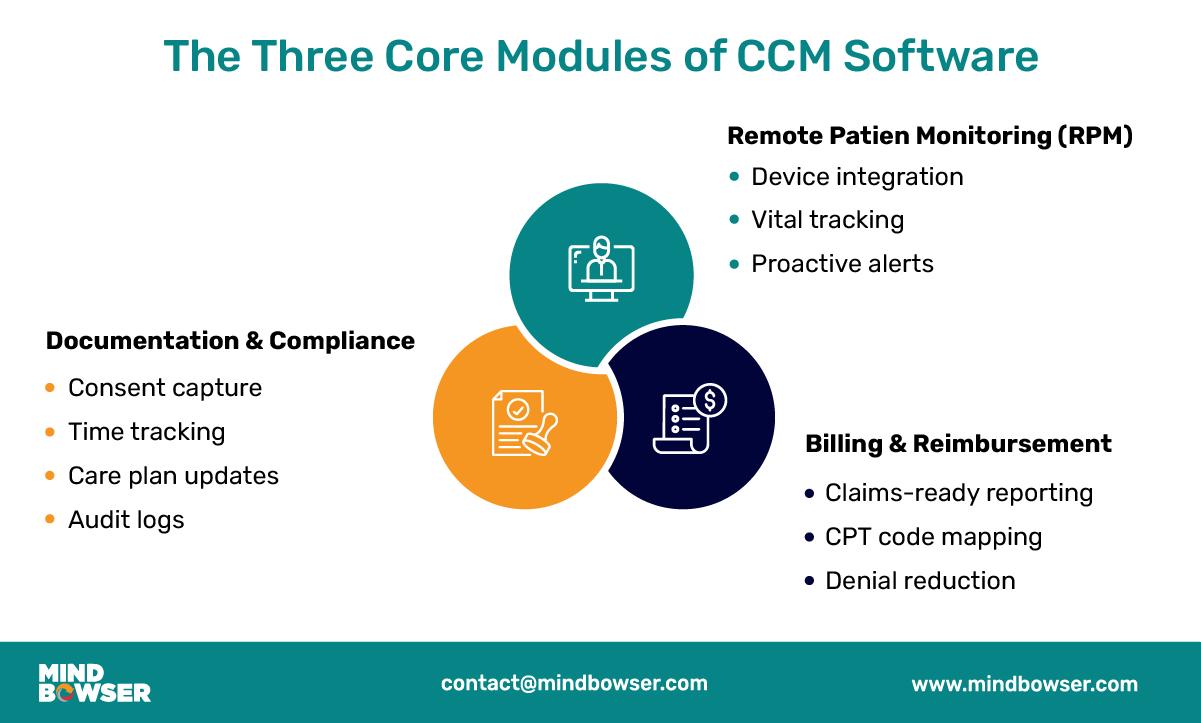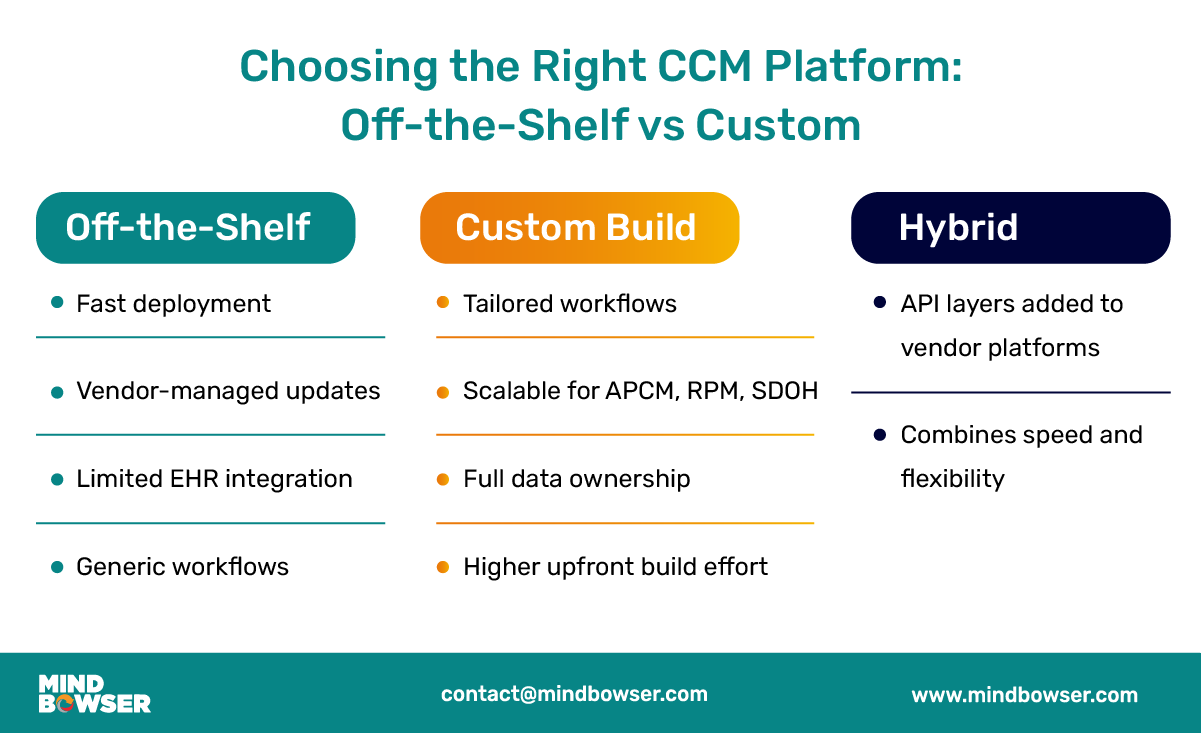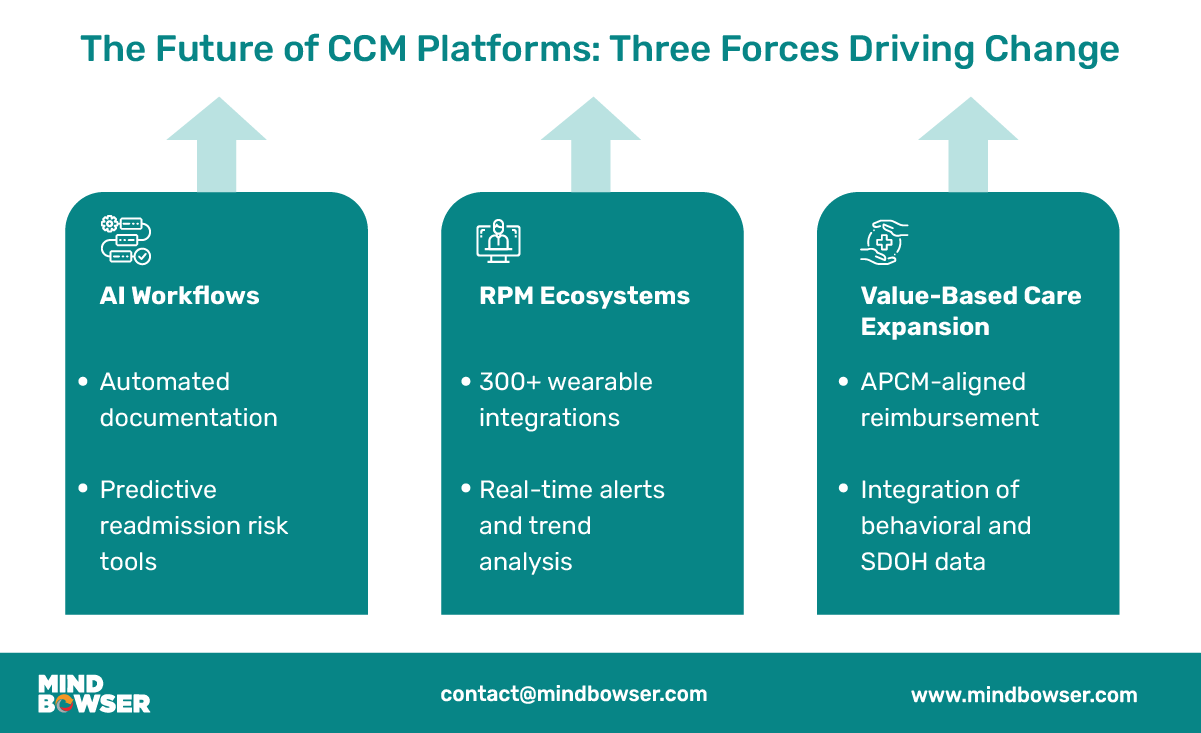Chronic care management software enables hospitals and digital health startups to enhance patient engagement, streamline documentation, and ensure billing compliance. The future lies in API-first builds, seamless RPM integration, and AI-enabled workflows. Mindbowser delivers scalable platforms that not only protect compliance but also drive measurable ROI in value-based care programs.
Chronic care management (CCM) has become one of the fastest-growing segments in U.S. healthcare, projected to expand from $6.63 billion in 2024 to as much as $14.50 billion by 2030. This growth is fueled by the increasing prevalence of chronic diseases, the expansion of CMS reimbursement, and the shift toward value-based care.
For hospitals, CCM presents both opportunities and pressures. While reimbursement creates a new revenue stream, leaders face mounting compliance risks, EHR integration gaps, and limited staff capacity. For startups, the challenge is different. Scaling engagement, proving ROI, and integrating with entrenched health system infrastructure requires more than a simple app.
This is where chronic care management software plays a decisive role. Purpose-built platforms bring together remote patient monitoring, documentation workflows, and billing automation into a single system. More importantly, the best platforms are designed with an API-first mindset, enabling interoperability across Epic, Cerner, Athena, and other EHRs.
In this blog, we will explore what CCM software is, compare off-the-shelf and custom-built solutions, highlight why API-first architecture matters, and examine how future-ready platforms are leveraging RPM and AI to drive sustainable value-based care. Finally, we will outline how Mindbowser helps hospitals and startups design CCM systems that deliver both compliance protection and measurable ROI.
Chronic care management software refers to technology platforms designed to help providers coordinate ongoing care for patients with multiple chronic conditions. At its core, the software is not just a digital filing cabinet but a living system that manages patient interactions, ensures compliance with CMS requirements, and supports revenue capture for care delivered outside the clinic.

Choosing the right type of chronic care management software is one of the most important decisions for hospitals and digital health startups. The market offers two primary pathways: adopting an off-the-shelf product from a vendor or developing a custom solution tailored to an organization’s specific needs. Increasingly, a hybrid middle ground is also emerging. Each path carries advantages and tradeoffs that leadership teams need to evaluate carefully.

In today’s healthcare environment, chronic care management software cannot operate as a silo. Hospitals and startups are increasingly expected to deliver care coordination across multiple platforms, EHRs, and devices. An API-first architecture ensures that CCM systems are not only interoperable but also future-ready for the rapid policy and technology changes shaping value-based care.
In short, API-first architecture is not just a technology preference. It is the difference between a platform that grows obsolete as EHR requirements evolve and one that positions hospitals and startups to thrive under value-based care.
Chronic care management is no longer a back-office billing program. It is becoming a strategic pillar for hospitals and startups navigating value-based care. The next wave of CCM platforms will be defined by three key forces: the integration of AI into clinical workflows, the expansion of remote patient monitoring ecosystems, and the alignment of software with new reimbursement models, such as APCM.

In short, the future of chronic care management platforms is being shaped by the convergence of various factors. AI will automate the repetitive. RPM will extend care beyond the clinic. And reimbursement frameworks like APCM will reward those who integrate medical and social complexity into care delivery.
Hospitals and startups evaluating chronic care management software often face a similar challenge: technology choices appear promising on paper but often fall short in real-world deployment. Mindbowser bridges that gap by building platforms that combine clinical insight, compliance discipline, and engineering strength. Our track record with mid-market hospitals and Series B+ digital health startups shows how custom builds can deliver measurable results.
These case studies demonstrate that success in CCM software is not solely about features. It is about embedding compliance, clinical workflows, and financial ROI into the core of the build.
By leveraging these accelerators, Mindbowser reduces development timelines, lowers implementation risk, and helps clients achieve compliance milestones more quickly.
In short, Mindbowser does more than write code. We build chronic care management ecosystems that protect compliance, enhance clinical efficiency, and generate sustainable ROI for hospitals and startups.

Chronic care management software has moved from being a back-office convenience to becoming a strategic necessity for hospitals and digital health startups. As reimbursement programs expand and value-based care contracts gain traction, the ability to coordinate, document, and bill for chronic care services is no longer optional.
The market is clear. Off-the-shelf platforms can get organizations started quickly, but they often lack the deep integrations and custom workflows required for long-term success. API-first, custom, or hybrid platforms provide the flexibility to grow in response to evolving reimbursement models, such as APCM, and the increasing importance of social determinants of health.
The future is already taking shape. AI-powered documentation tools, predictive risk models, and wearable integrations are reshaping how care teams manage chronic conditions. At the same time, audit-proofing, compliance automation, and ROI modeling are becoming essential safeguards in an environment where denials are costly and can have significant financial implications.
Hospitals and startups that make strategic investments in CCM software will not only improve patient outcomes but also build sustainable revenue streams. Mindbowser stands as a trusted partner in this journey, delivering platforms that combine compliance, interoperability, and measurable ROI.
Chronic care management software is a platform that helps providers coordinate and document care for patients with multiple chronic conditions. It typically includes remote patient monitoring, documentation workflows, and billing automation to support compliance with CMS requirements.
The software standardizes time tracking, consent, and care plan updates while linking activities to CPT codes. This creates audit-ready documentation that reduces denials and ensures providers are reimbursed accurately for the services they deliver.
Off-the-shelf platforms enable quick deployment but often lack in-depth EHR integration and customized workflows. Custom builds, on the other hand, give organizations control over their data plane, allow for scalability with evolving reimbursement models, and align more closely with clinical workflows.
API-first architecture ensures interoperability with EHRs like Epic, Cerner, and Athena. It also enables seamless data exchange, automates audits, and allows for the streaming of encounter artifacts into enterprise data lakes for predictive analytics and compliance monitoring.
AI supports CCM by automating documentation, predicting readmission risk, and analyzing wearable data for early intervention. These capabilities reduce staff burden, enhance patient engagement, and enable organizations to thrive under value-based care models.

We worked with Mindbowser on a design sprint, and their team did an awesome job. They really helped us shape the look and feel of our web app and gave us a clean, thoughtful design that our build team could...


The team at Mindbowser was highly professional, patient, and collaborative throughout our engagement. They struck the right balance between offering guidance and taking direction, which made the development process smooth. Although our project wasn’t related to healthcare, we clearly benefited...

Founder, Texas Ranch Security

Mindbowser played a crucial role in helping us bring everything together into a unified, cohesive product. Their commitment to industry-standard coding practices made an enormous difference, allowing developers to seamlessly transition in and out of the project without any confusion....

CEO, MarketsAI

I'm thrilled to be partnering with Mindbowser on our journey with TravelRite. The collaboration has been exceptional, and I’m truly grateful for the dedication and expertise the team has brought to the development process. Their commitment to our mission is...

Founder & CEO, TravelRite

The Mindbowser team's professionalism consistently impressed me. Their commitment to quality shone through in every aspect of the project. They truly went the extra mile, ensuring they understood our needs perfectly and were always willing to invest the time to...

CTO, New Day Therapeutics

I collaborated with Mindbowser for several years on a complex SaaS platform project. They took over a partially completed project and successfully transformed it into a fully functional and robust platform. Throughout the entire process, the quality of their work...

President, E.B. Carlson

Mindbowser and team are professional, talented and very responsive. They got us through a challenging situation with our IOT product successfully. They will be our go to dev team going forward.

Founder, Cascada

Amazing team to work with. Very responsive and very skilled in both front and backend engineering. Looking forward to our next project together.

Co-Founder, Emerge

The team is great to work with. Very professional, on task, and efficient.

Founder, PeriopMD

I can not express enough how pleased we are with the whole team. From the first call and meeting, they took our vision and ran with it. Communication was easy and everyone was flexible to our schedule. I’m excited to...

Founder, Seeke

We had very close go live timeline and Mindbowser team got us live a month before.

CEO, BuyNow WorldWide

Mindbowser brought in a team of skilled developers who were easy to work with and deeply committed to the project. If you're looking for reliable, high-quality development support, I’d absolutely recommend them.

Founder, Teach Reach

Mindbowser built both iOS and Android apps for Mindworks, that have stood the test of time. 5 years later they still function quite beautifully. Their team always met their objectives and I'm very happy with the end result. Thank you!

Founder, Mindworks

Mindbowser has delivered a much better quality product than our previous tech vendors. Our product is stable and passed Well Architected Framework Review from AWS.

CEO, PurpleAnt

I am happy to share that we got USD 10k in cloud credits courtesy of our friends at Mindbowser. Thank you Pravin and Ayush, this means a lot to us.

CTO, Shortlist

Mindbowser is one of the reasons that our app is successful. These guys have been a great team.

Founder & CEO, MangoMirror

Kudos for all your hard work and diligence on the Telehealth platform project. You made it possible.

CEO, ThriveHealth

Mindbowser helped us build an awesome iOS app to bring balance to people’s lives.

CEO, SMILINGMIND

They were a very responsive team! Extremely easy to communicate and work with!

Founder & CEO, TotTech

We’ve had very little-to-no hiccups at all—it’s been a really pleasurable experience.

Co-Founder, TEAM8s

Mindbowser was very helpful with explaining the development process and started quickly on the project.

Executive Director of Product Development, Innovation Lab

The greatest benefit we got from Mindbowser is the expertise. Their team has developed apps in all different industries with all types of social proofs.

Co-Founder, Vesica

Mindbowser is professional, efficient and thorough.

Consultant, XPRIZE

Very committed, they create beautiful apps and are very benevolent. They have brilliant Ideas.

Founder, S.T.A.R.S of Wellness

Mindbowser was great; they listened to us a lot and helped us hone in on the actual idea of the app. They had put together fantastic wireframes for us.

Co-Founder, Flat Earth

Mindbowser was incredibly responsive and understood exactly what I needed. They matched me with the perfect team member who not only grasped my vision but executed it flawlessly. The entire experience felt collaborative, efficient, and truly aligned with my goals.

Founder, Child Life On Call

The team from Mindbowser stayed on task, asked the right questions, and completed the required tasks in a timely fashion! Strong work team!

CEO, SDOH2Health LLC

Mindbowser was easy to work with and hit the ground running, immediately feeling like part of our team.

CEO, Stealth Startup

Mindbowser was an excellent partner in developing my fitness app. They were patient, attentive, & understood my business needs. The end product exceeded my expectations. Thrilled to share it globally.

Owner, Phalanx

Mindbowser's expertise in tech, process & mobile development made them our choice for our app. The team was dedicated to the process & delivered high-quality features on time. They also gave valuable industry advice. Highly recommend them for app development...

Co-Founder, Fox&Fork
